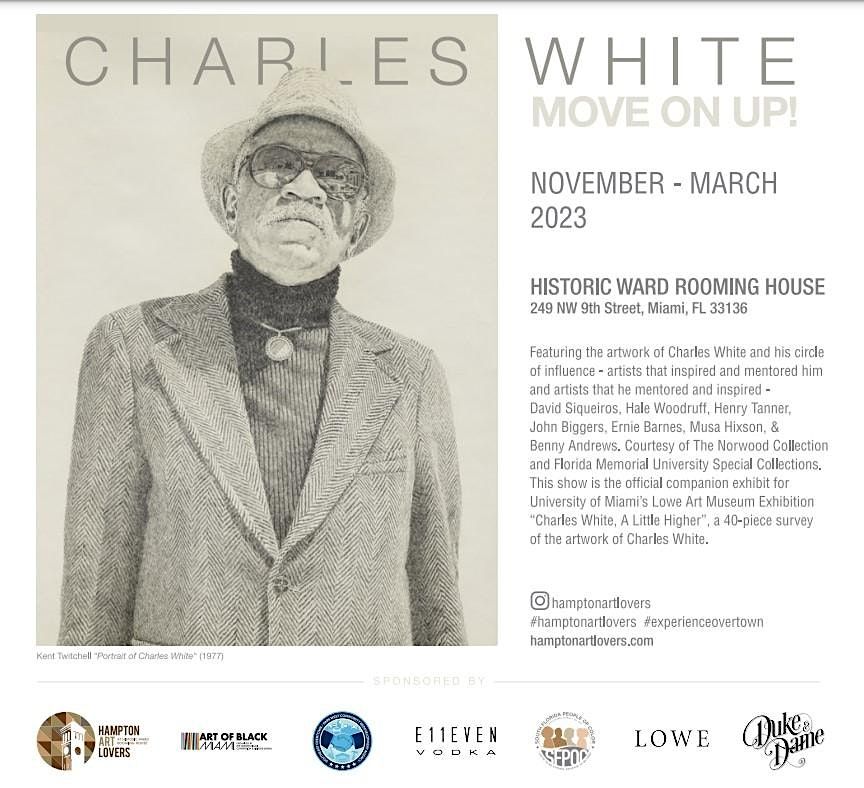Hampton Art Lovers Presents: "Charles White, Move On Up!"
Schedule
Thu Feb 02 2023 at 12:00 pm to 06:00 pm
Location
Historic Ward Rooming House | Miami, FL

About this Event
Hampton Art Lovers Presents "Charles White, Move on Up!" from The Norwood Collection and Florida Memorial University Special Collection, featuring the artwork of Charles White and his circle of influence - artists that inspired and mentored him and artists that he mentored and inspired - David Siqueiros, Benny Andrews, Hale Woodruff, Henry Tanner, John Biggers, Samella Lewis, Romare Bearden, Jacob Lawrence, Ernie Barnes, Barrington Watson, Musa Hixson and Marvin Weeks. This show is the official companion exhibit for the Lowe Art Museum's (University of Miami) Exhibition "Charles White, A Little Higher", a 40 piece survey of the artwork of Charles White (1918-1979). This show is the official companion exhibit for the Lowe Art Museum's (University of Miami) Exhibition "Charles White, A Little Higher", a 40 piece survey of the artwork of Charles White (1918-1979).
The names of the respective shows at the Lowe Museum & Historic Ward Rooming House in Overtown, is a play on words and unites a consistent theme within White's work. Charles White created a charcoal drawing entitled "Move on Up, a Little Higher", a drawing that conveys all the emotional and figurative realism one associates with Charles White. The title refers to the gospel song of Mahalia Jackson whose 1948 recording made her famous. We hope "Move on Up" and "A Little Higher" literally and figuratively becomes one, providing the viewer a total unitary experience.
____________________________________________
Charles White
When interviewed about his art, Charles Wilbert White said: “Paint is the only weapon that I have with which to fight what I resent. If I could write, I would write about it. If I could talk, I would talk about it. Since I paint, I must paint about it.” A painter, draftsman, printmaker, educator and activist, White endeavored to marry his art to his beliefs. Using the plight of African Americans as his subject, White’s artwork speaks to the black experience in the United States.
Born in Chicago, Illinois, Charles White’s artistic gifts became evident in grade school when his teachers marked him as “gifted with the paintbrush and the pencil.” Although his home life was unstable and impoverished, White’s single mother—a native Southerner who had migrated north from Mississippi — encouraged his talent, once bringing home a set of oil paints. Days spent at the Chicago Public Library (often in lieu of child care) nurtured White’s love of reading and exposed him to the writers and artists of the Harlem Renaissance. His youthful proficiency at drawing earned a scholarship to Saturday classes at the Art Institute of Chicago, where his instructors included Charles Sebree and Margaret Burroughs. In 1937, White received another scholarship to attend the Art Institute, one of the few schools open to black artists at that time.
After completing the Art Institute’s two-year program in just twelve months, White joined the ranks of artists employed by the Works Progress Administration. He worked briefly in the easel division of the Illinois branch of the Federal Art Project before transferring to the mural department, where his colleagues included former assistants of Mexican muralists Diego Rivera and José Clemente Orozco. Under WPA auspices, White executed Five Great American Negroes, the first of many important murals he would create to honor key African American leaders such as Sojourner Truth, Booker T. Washington, Frederick Douglass, Marian Anderson, and George Washington Carver. This introduction to politically engaged public art left a lasting impact on White who strove to use his creativity for social justice.
In the summer of 1941, White met Elizabeth Catlett while she was studying ceramics at the Art Institute of Chicago. They married in December of that year and moved to New Orleans where Catlett was chair of the art department at Dillard University, and White obtained an appointment to teach drawing for one semester. A year later, White won a Julius Rosenwald Foundation fellowship; as part of the award’s stipulations, the couple relocated to New York, and White joined the Art Students League’s faculty. That fall, White and Catlett toured the South, an experience he would later recount as “one of the most deeply shaking and educative experiences of my life.” After traveling for over a year, White began work on a massive mural documenting African American history, "The Contribution of the Negro to American Democracy", at the Hampton Institute (now Hampton University) in Virginia. It became his best known work.
White was drafted in 1944 into WWII and served as a corporal in the all-black 132nd Engineering Regiment for eight months before being diagnosed with and then honorably discharged for tuberculosis. During his extended convalescence, White spent the spring of 1945 as an artist-in-residence at Howard University in Washington, DC, an appointment that offered a lighter teaching load. When Elizabeth Catlett received her own Rosenwald fellowship in 1946, White followed her to Mexico. While she worked on a series centered on African American women, he was able to study directly with the muralists he had admired since his time in the WPA. The pair also became associated with the Taller de Gráfica Popular, an artists’ print collective where White honed his skills in lithography. As White’s health improved in the warm climate, his marriage to Catlett deteriorated, and the couple divorced in 1947.
Back in New York, White continued to create a socially conscious body of work. “Art,” he believed, “must be an integral part of the struggle.” His political affiliations during the McCarthy era attracted the attention of–and a subpoena from—the FBI. It was around this time that the dense, dynamic Social Realist style that had characterized White’s earlier output gave way to works on paper executed in charcoal or muted oils, works the artists described as “images of dignity.”
In 1956, White sought relief for his ongoing battle with tuberculosis by moving to Southern California. From 1965 until his death in 1979, White taught at the Otis Art Institute, fostering a new generation of socially conscious artists.
White was the recipient of numerous awards and honors during his lifetime, including his 1972 election as a full member (and only the third African American member) of the National Academy of Design. His work is held in several renowned art museums such as the Museum of Modern Art, the Art Institute of Chicago, and the Los Angeles County Museum of Art, among others. In 2018, the Art Institute of Chicago mounted the first major survey of the artist’s expansive career, Charles White: A Retrospective
Where is it happening?
Historic Ward Rooming House, 249 Northwest 9th Street, Miami, United StatesEvent Location & Nearby Stays:
USD 0.00
